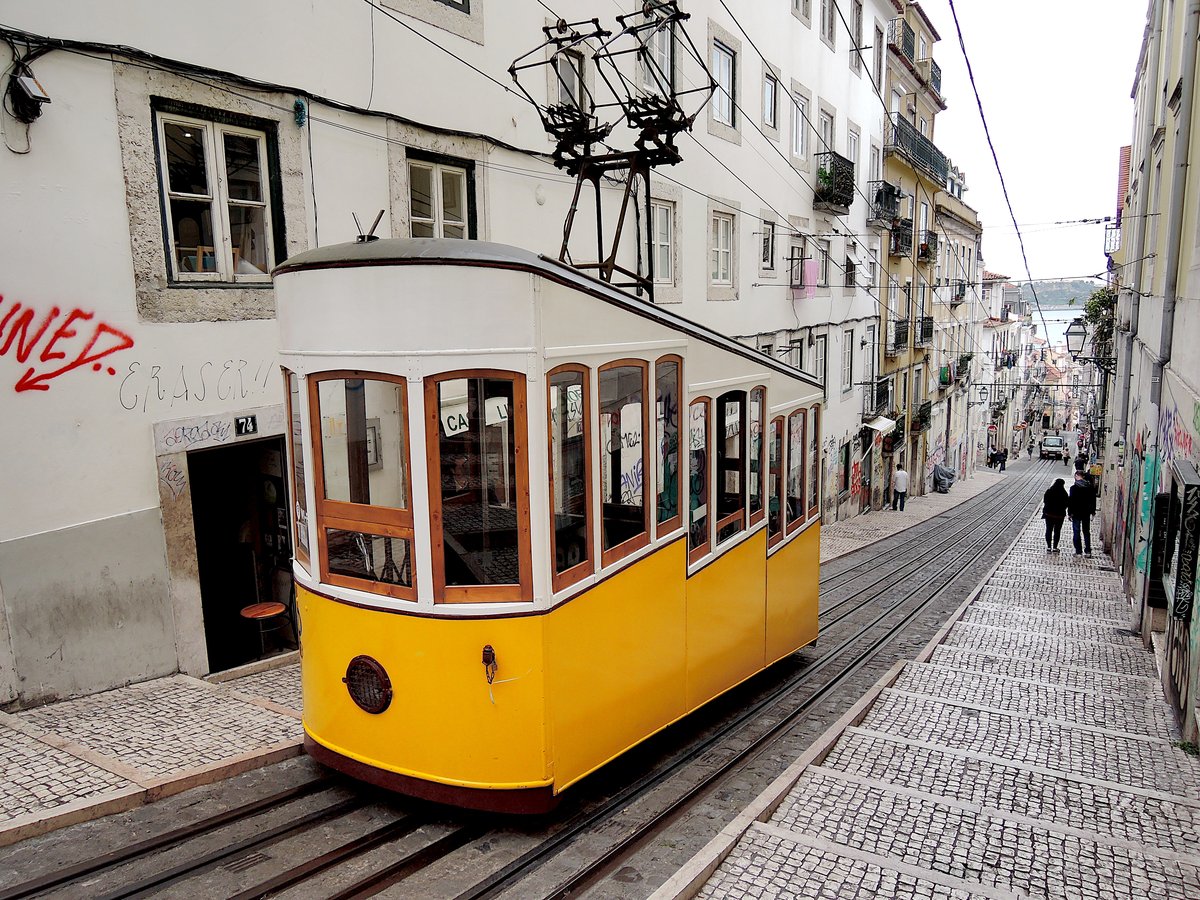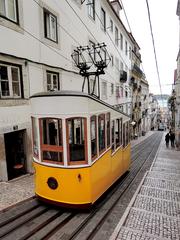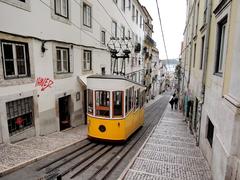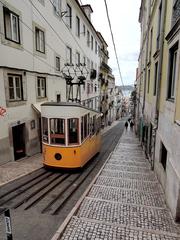
Ascensor da Bica Visiting Hours, Tickets, and Historical Significance in Lisbon
Date: 14/06/2025
Introduction
Nestled in the heart of Lisbon, the Ascensor da Bica stands as both a practical solution to the city’s famously steep hills and an enduring symbol of its innovative spirit. Since its inauguration in 1892, this iconic funicular has connected the bustling Cais do Sodré district to Bairro Alto, offering visitors a unique passage through narrow, azulejo-lined streets and panoramic city views. Today, the Bica Funicular is not only a vital piece of public transport but also a living testament to Lisbon’s layered history—captivating history enthusiasts, photographers, and travelers alike. In this guide, you’ll find everything you need to know about visiting hours, ticket options, cultural significance, accessibility, and the best tips for making your Lisbon experience truly memorable (Voyage & Venture; Lisboasecreta; Codandham).
Urban Context and Neighborhood Integration
The Role of Ascensor da Bica in Lisbon’s Urban Fabric
The Ascensor da Bica (Bica Funicular or Elevador da Bica) is a vital link between the lower Cais do Sodré and the upper Bairro Alto. Its steep tracks, running 245 meters with a gradient approaching 12%, transform what would be a strenuous climb into a scenic and accessible journey. This connection has historically supported the daily lives of Lisbon’s residents, facilitating access to commerce and social venues, and continues today as a bridge between local communities and visitors (Voyage & Venture).
Preservation and Urban Identity
From its origins as a water counterbalance system to its current electric operation, the Ascensor da Bica has retained its historic charm. Its classic yellow tramcars, wood interiors, and brass controls have been carefully preserved, making it a beloved photographic subject and a symbol of Lisbon’s commitment to heritage. The funicular anchors the identity of the Bica neighborhood, with its colorful facades and narrow staircases embodying the city’s architectural vernacular.
Practical Visitor Information
Ascensor da Bica Visiting Hours
- Monday to Saturday: 7:00 am – 9:00 pm
- Sundays and Public Holidays: 9:00 am – 9:00 pm
Trams depart approximately every 12 minutes during peak hours, ensuring minimal waiting times (Lisboavibes; LisbonLisboaPortugal).
Tickets and Pricing
- Onboard Ticket: €3.80 (valid for two trips on the same day; cash only on board) (Codandham)
- 24-Hour Pass: €6.80–€7.00 (unlimited travel on Carris trams, buses, metro, and funiculars) (LisbonLisboaPortugal; Codandham)
- Navegante Card with “Zapping” Credit: €1.70 per ride (Portugal.com)
- Contactless Payments: Not accepted onboard; purchase tickets at metro stations such as Cais do Sodré (Portugal.com).
Tip: Save money and time by purchasing integrated transport passes at metro stations before your visit.
Accessibility
Due to its historic construction and the steep, narrow streets at both stations, the Ascensor da Bica is not fully wheelchair accessible and can be challenging for visitors with limited mobility. Space is also limited inside the cars, so traveling with large luggage is not recommended.
Travel Tips
- Best Time to Visit: Early morning (before 10:00 am) or late afternoon (after 4:00 pm) to avoid crowds (Lisboavibes).
- Photography: For the most iconic shot, stand at the top of Rua da Bica de Duarte Belo, looking down toward the river.
- Combine with Walking: Ride the funicular one way and explore the neighborhood on foot for a richer experience.
- Cash: Have exact change ready if buying onboard tickets.
History and Cultural Significance
A Living Monument
Opened in 1892, the Ascensor da Bica was engineered to conquer Lisbon’s hills and now stands as one of the city’s three historic funiculars, alongside the Elevador da Glória and Elevador do Lavra (Wikipedia). Its enduring operation reflects Lisbon’s innovative approach to urban mobility and its dedication to preserving historical landmarks.
The funicular has become a cultural icon, featured in films, art, and travel literature. Its yellow tramcars climbing the steep, cobbled streets have come to symbolize the spirit of Lisbon—a blend of tradition, resilience, and vibrancy (Voyage & Venture).
Social and Economic Impact
The Bica Funicular not only facilitates movement but also supports local businesses, from bakeries like Manteigaria (famous for Pastel de Nata) to neighborhood cafés and shops. The area’s vibrancy owes much to the steady flow of visitors drawn by the funicular’s charm. Guided tours and cultural festivals occasionally include the funicular, deepening its connection to community life (Lisboasecreta).
Visiting Experience
Capacity and Ride Details
Each tramcar holds up to 23 passengers (9 seated, 14 standing). The ride lasts about three minutes, providing ample time to soak in views of colorful buildings and glimpses of the Tagus River—especially scenic from the upper station (Lisboavibes).
Nearby Attractions
- Bairro Alto: Known for nightlife, Fado music, and lively atmosphere.
- Chiado: Cultural and shopping hub with theaters and historic cafés.
- Time Out Market: Renowned food hall near Cais do Sodré (LisbonLisboaPortugal).
- Miradouro de Santa Catarina: Panoramic viewpoint over Lisbon and the Tagus River.
- Largo de Camões: A vibrant square near the upper station.
Heritage Conservation and Contemporary Challenges
As a National Monument, the Ascensor da Bica is subject to strict conservation protocols. Balancing heritage preservation with the demands of modern tourism remains an ongoing challenge—particularly given the funicular’s popularity and the pressures of urban development (Voyage & Venture). Local authorities and community groups work to maintain the funicular’s authenticity while ensuring it remains accessible and relevant to both residents and visitors.
Frequently Asked Questions (FAQ)
What are the Ascensor da Bica visiting hours?
Monday to Saturday: 7:00 am – 9:00 pm; Sundays/Public Holidays: 9:00 am – 9:00 pm.
How much are tickets?
€3.80 onboard (covers two trips, same day); integrated passes and Navegante card offer cheaper options.
Is it wheelchair accessible?
No, due to the historic design and steep stations.
When is the best time to visit?
Early mornings or late afternoons are less crowded.
Are there guided tours?
Yes, some historical and transport-themed tours include the funicular; check local providers for details.
Essential Facts
- Route Length: 245 meters (804 feet)
- Incline: 11.8%
- Opened: 1892
- Operator: Carris
- Route Number: 53E
- Fare (onboard): €3.80 (two trips, same day)
- Fare (with Navegante/Zapping): €1.70 per ride
- 24-Hour Pass: €6.80–€7.00
For current details, consult the Carris website or Portugal.com.
Visuals and Media
- Route Map: Map showing the line between Cais do Sodré and Bairro Alto.
- Iconic Yellow Tramcar: Photo of the yellow funicular car on the steep Bica street.
Summary and Final Tips
The Ascensor da Bica is a quintessential Lisbon experience, merging historical ingenuity, urban charm, and community vibrancy. Whether you’re riding for practical transit, cultural discovery, or that perfect photograph, planning ahead—especially regarding tickets and timing—ensures a smooth and enjoyable visit. Don’t miss the chance to explore nearby attractions and indulge in local treats like pastéis de nata after your ride.
References
- Ascensor da Bica: Visiting Hours, Tickets, and Exploring Lisbon’s Historic Funicular (Voyage & Venture)
- Ascensor da Bica Guide (Lisboasecreta)
- Bica Funicular Info and Tips (Codandham)
- Elevador da Bica - Funicular Lisbon (LisbonLisboaPortugal)
- Elevador da Bica (Lisboavibes)
- An Updated Transport Guide to Lisbon 2025 (Portugal.com)
- Official Carris Website (Carris)





























































